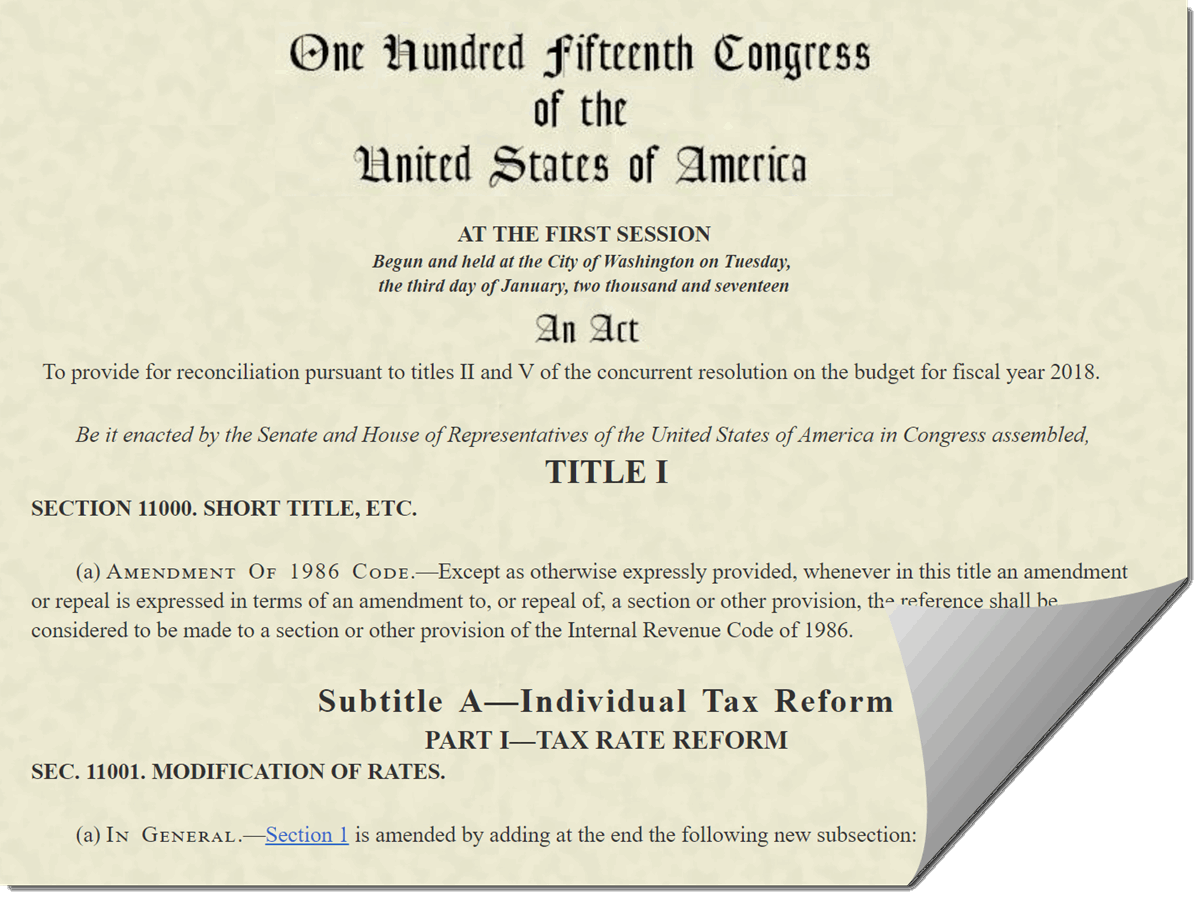HERE’S HOW THE NEW 2018 TAX LAW CAN AFFECT YOUR COLLEGE FUNDING CLIENTS

Just in time for 2018, Congress pushed through the new tax-overhaul bill. No doubt many CCFS® advisors are wondering how these new laws will impact their clients’ financial aid. I know this because I have been inundated with emails and support questions regarding the subject.
I read IRS code a lot.I have a deep knowledge base regarding taxes. I have access to some of the best CPAs in the country. We have many members that are CPAs. I have read the new tax bill and I have consulted with a few CPAs about the new tax bill. However, before you read my analysis on how the new tax code can affect your college funding clients, let me issue the following caveat: I, Ron Them, am not a CPA nor a tax expert. I do not run a tax service, or get paid to provide tax advice.
Furthermore, our position here at the Association of Certified College Funding Specialists is to educate financial professionals in college funding. There are many tax strategies we cover in our courses and content, however, just because you may learn a few tax strategies, you should never present yourself as a tax expert or provide complex tax advice unless you are a CPA, Enrolled Agent or a tax professional.
Now that we have that out of the way, how does the new 2018 tax law affect your college funding clients? Specifically, in regards to cash flow and financial aid, the simple answer is...
It depends.
If your taxes end up being lower under the new tax law, then lower taxes means additional cash flow to cover college costs. However, financial aid is the opposite. Taxes paid (owed) is actually a financial aid deduction. So lower taxes paid means a lower financial aid deduction, resulting in higher financial aid income and lower financial aid eligibility.
Let me explain in more detail.
When CPAs talk about taxes and deductions, or credits, etc. they refer to “above-the-line” and “below-the-line”. Above-the-line simply means any line item above Adjusted Gross Income on the IRS tax form (1040 - line 37; 1040A - line 21; or 1040EZ - line 4). Below-the-line means any line item below Adjusted Gross Income on the IRS tax form.
Adjusted Gross Income is the driving force in the Expected Family Contribution formula and financial aid eligibility. Since almost all the new tax changes are “below-the-line”, Adjusted Gross Income will not be affected, only taxes paid. Therefore, in most financial aid cases, lower taxes will mean a slightly higher Expected Family Contribution and lower financial aid eligibility.
Taxes are already a confusing subject for most and when you add the Expected Family Contribution formula to that subject, it becomes clear why families need special guidance to complete their financial aid application forms.
Now, let’s take a closer look at some of the main 2018 tax law changes and how they will directly affect your college-bound clients. Please remember, these new tax law changes are for the 2018 tax year, which means they will not affect financial aid until the 2020-2021 FAFSA filing year, since financial aid income is looked at two years in arrears.
NEW TAX LAWS REFLECTING EDUCATION
Tax Bracket Adjustments
The 2018 income tax brackets have been reduced and the income maximums have been increased. This should lower taxes for most families.
|
Tax Rate |
Single |
Married |
Head of Household |
|
10% |
0 to $9,525 |
0 to $19,050 |
0 to $13,600 |
|
12% |
$9,526 to 38,700 |
$19,051 to 77,400 |
$13,601 to 51,800 |
|
22% |
$38,701 to 70,000 |
$77,401 to 165,000 |
$51,801 to 82,500 |
|
24% |
$70,001 to 160,000 |
$165,001 to 315,000 |
$82,501 to 157,500 |
|
32% |
$160,001 to 200,000 |
$315,001 to 400,000 |
$157,501 to 200,000 |
|
35% |
$200,001 to 500,000 |
$400,001 to 600,000 |
$200,001 to 500,000 |
|
37% |
Over $500,000 |
Over $600,000 |
Over $500,000 |
Standard Deductions
Standard deductions have nearly doubled for most taxpayers in 2018, however, personal exemptions go from $4,050 per taxpayer to zero. This means that a married family filing a joint tax return with just one child could potentially see an increase in their taxes.
|
Filing Status |
2018 Deduction |
2017 Deduction & Exemption (Family with 1 child) |
|
Single |
$12,000 |
$10,400 ($6,350 + $4,050) |
|
Married Filing Jointly |
$24,000 |
$25,150 ($12,700 + $4,050 x 3) |
|
Head of Household |
$18,000 |
$17,450 ($9,350 + $4,050 x 2) |
Child Tax Credit
However, this potential personal deduction loss for families with one child or more should be made up for by the expanded Child Tax Credit, which is available for qualified children under age 17. The new tax bill doubles the credit from $1,000 to $2,000, and also increases the amount of the credit that is refundable to $1,400.
In addition, the phase-out threshold for the child tax credit is dramatically increasing.
|
Tax Filing Status |
Old Phaseout Threshold |
New Phaseout Threshold |
|
Married Filing Jointly |
$110,000 |
$400,000 |
|
Individuals |
$75,000 |
$200,000 |
Education Tax Credits & Deductions
Under the 2018 tax law, some of the education tax credit income phase-outs will change also.
Lifetime Learning Credit
This Lifetime Learning Credit is a non-refundable tax credit, worth a possible maximum of $2,000. For the 2018 tax year, the MAGI limit is now $57,000, or $114,000 if you're married and file a joint tax return.
Student Loan Interest
Up to $2,500 of interest paid on qualifying student loans is deductible as an income adjustment. This is one of the few deductions that qualify as an above-the-line deduction.
In 2018, your student loan interest deduction is phased out at $65,000, or $135,000 if you're married and file jointly. The interest deduction is completely eliminated if your MAGI as a single taxpayer is $80,000 and $165,000 for married joint filers.
Savings Bond Exclusion For Higher Education
Savings bonds are another way to help pay for some higher education costs, and for the year 2018, this exclusion will start phasing out at $79,700, and $119,550 for joint returns. The tax-free savings bond interest exclusion is completely phased out for joint filers with MAGI of $94,700, or $149,550 for joint returns.
529 Plan
Under the 2018 tax law, parents can now use 529 plans to cover tuition at private elementary and high schools, similar to the Coverdell. The real benefits here is for affluent families, many who already have kids in private K-12 schools. They can now use a new, or even an old 529 plan, to help pay for private elementary and high school tuition, plus get a state tax deduction.
20% Pass-through Business Income Deduction
If you have business owner clients, the 20% pass-through deduction for those with qualified trade or business income (Section 199A) could be a big deal. This includes income earned by sole proprietorships, LLCs, partnerships, and S corporations.
Under the new law, taxpayers with pass-through businesses will be able to deduct 20% of their pass-through income. In other words, if you own a small business and it generates $100,000 in profit in 2018, you'll be able to deduct $20,000 of it before the new 2018 tax rates are applied.
However, people in professional service industries are restricted. Any trade or business involving the performance of services in the fields of health, law, engineering, architecture, accounting, actuarial science, performing arts, consulting, athletics, financial services, brokerage services, or any trade or business where the principal asset of the business is the reputation or skill of 1 or more of its employees will have phase-out income limits that apply. These income limits are set at $157,500 for single filers and $315,000 for pass-through business owners who file a joint return.
In other words, you can make money in college funding, just not too much money.
Again, these are just a few general tax law changes that could affect the majority of college-bound families. Of course, there is a myriad of additional tax changes not covered here, such as the Earned Income Tax Credit, Alternative Minimum Tax (AMT), Miscellaneous Deductions, and many others. Go deeper and read the entire bill.
Posted by Ron Them
He is a former Chief Financial Officer of a Fortune 500 company and currently owns his own financial advisory company specializing in cash flow planning for business owners and executives. He developed the Cash Flow Recovery™ process that uses cash flow management principals to increase asset value and build wealth for business owners.
He is also the originator of several software calculators to help advisors and families make college affordable, including:
* College QuikPlan EFC Calculator
* "Find the Money" College Cash Flow Calculator
* College Debt Reduction Calculator
Ron has been quoted in U.S. News and World Report, Kiplinger's Personal Finance, Smart Money, Financial Advisor Magazine, Small Firm Profit Report, Practical Accountant, LIMRA's Market Facts, Senior Advisors Magazine, HR Magazine, BenefitNews.com, Employee Benefit News Magazine, ProducersWeb.com, Entrepreneur Magazine, Insurance Selling Magazine, CollegeNews.com, The Christian Voice, and Columbus CEO Magazine.

